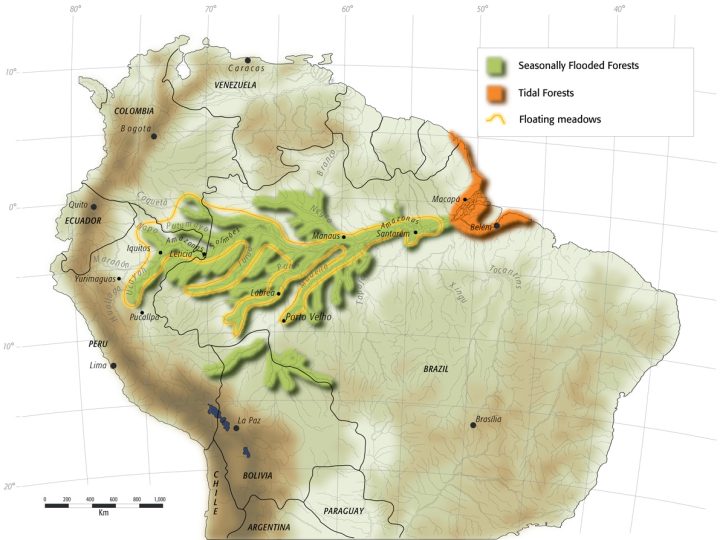
Written by: Guillermo Estupiñán
Four and a half years after the launch of the Ictio app and platform (Ictio.org), we reached the milestone of 91,431 fish observations in 52,874 lists (fishing events), as a result of the collaboration of 614 users, including citizen scientists and institutions who actively participate in the Citizen Science Network for the Amazon by sharing data through the Ictio app and web platform (Ictio.org). This information was generated in 150 Amazon tributary basins constituting 75% of the total 199 BL4 basins – the fourth hierarchical basin level detail according to Venticinque et al . 2016.
Ictio users are a key contributing factor to the growth of the database and its geographic extent. Of the 614 registered users, 602 contribute data to the Ictio app, whether they are citizen scientists and people linked or not to institutions with diverse activities in and out the Amazon region. There are also 18 institutional users who contribute fish and fisheries data from monitoring and research projects, through the data upload tool on the Ictio platform. We highlight the contributions of the AmazonFish Project, the Ação Ecológica Guaporé (Ecoporé) and the Federal University of Rondônia (UNIR) and the Mamirauá Sustainable Development Institute (IDSM), which made important data contributions.
For this note we reviewed and excluded from the analysis the records of the beta tests and the lists and observations made during training exercises, as long as they were identified as such. A total of 266 records were excluded from this analysis. Ongoing checks will be performed to ensure the robustness of the database and the overall results presented on a quarterly basis.
The total number of observations shared in this quarter (July to September 2022) expirienced an increase of 1.3% over the cumulative number up to the previous quarter (April to June 2022: 90,266 observations). The number of lists increased by 1.6% over the previous quarter cited, when 52,057 lists were sent. All increases were due to data submitted through the application, and there were no new data entered from the upload tool this quarter.
The Ictio database consists of two forms of submissions: through the application and by uploading from the platform. The majority of the uploaded lists come from the platform, with 78.6% (41,568), while 21.4% (11,306) are data uploaded by the application. This information highlights the importance of the partnerships established in the Network to make Ictio the largest open database of fish and fisheries in the Amazon. The total number of fish lists (shared with the application and by the Ictio platform) by BL4 sub-basin can be visualized in Figure 1. Among the lists cited above, the Amazon/Solimões river basin (between Juruá and Negro) stands out with 12,688 lists, followed by the Tefé river basin with 5,49 fish lists.
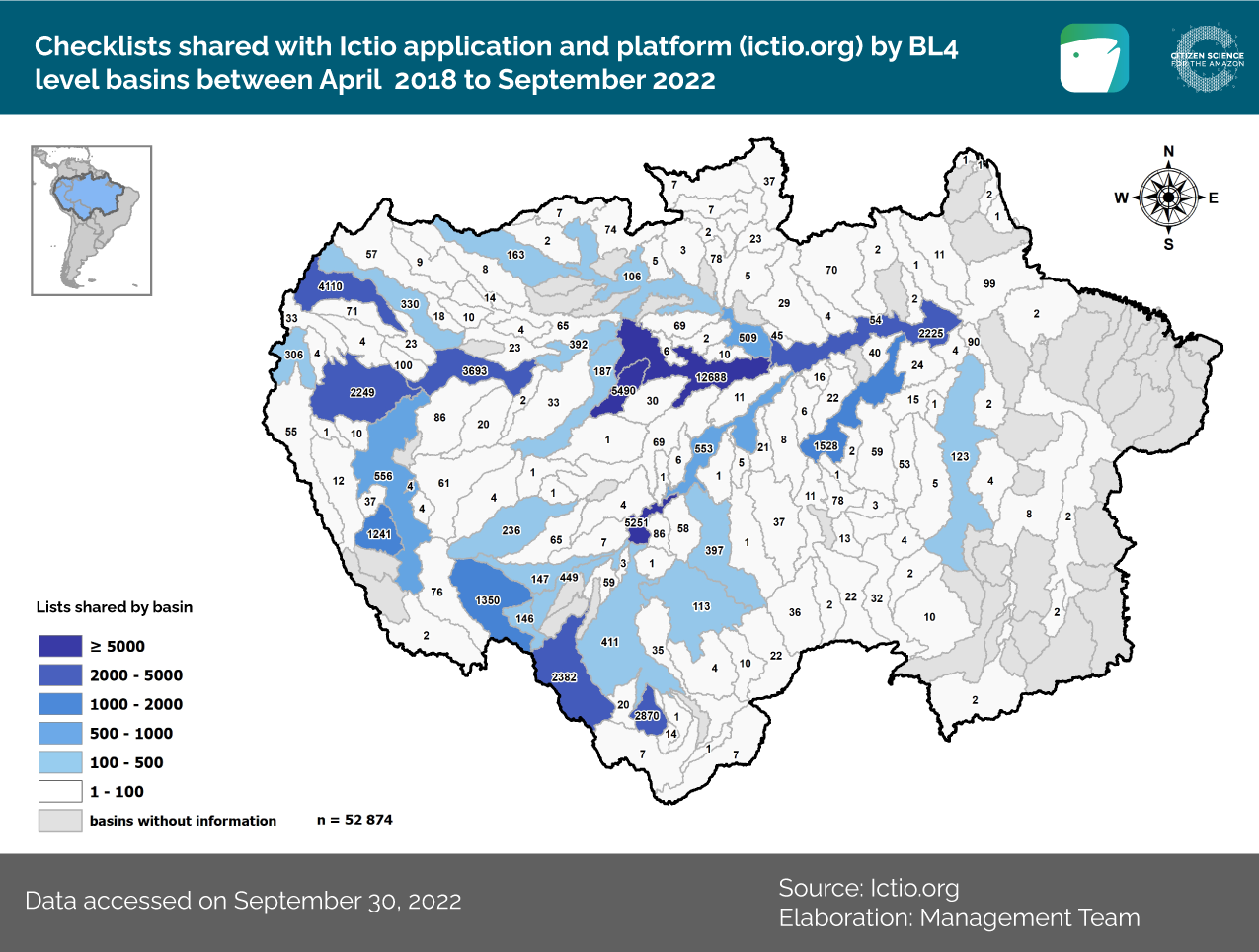
Figure 1. By September 30, 2022, Ictio gathers a total of 52,874 lists (fishing events). This information was generated in 150 Amazon basins, constituting 75% of the total 199 BL4 level basins, product of the work of 614 individuals and organizations. Data corresponding to the period from April 2018 to September 2022, consulted on October 1, 2022.
Source: Ictio.org
Prepared by: Wildlife Conservation Society
Figure 2 shows the ten basins with the most lists registered with the Ictio application, highlighting the Amazon River channel (above Jandiatuba and between Negro and Xingu) and the Tapajós River.

Figure 2. Ranking of the 10 BL4 basins with more lists registered in the Ictio application. The graph follows the trend of having the Amazon BL4 basin (above Jandiatuba) in the first place. This basin stands out for being the basin that is most often among the first places with the highest number of registered listings. Data up to September 30, 2022.
Source: Ictio.org
Prepared by: Wildlife Conservation Society
In relation to the number of fish observations (which are part from a list), 79.8% (72,948) of the observations were recorded by uploading through the platform, and 20.2% (18,483) were sent through the app. Here, the Madeira River basin (above Jamari) stands out with 16,175 fish observations, followed by the Amazon/Solimões River basin (between Juruá and Negro) with 14,800 observations (Figure 3).
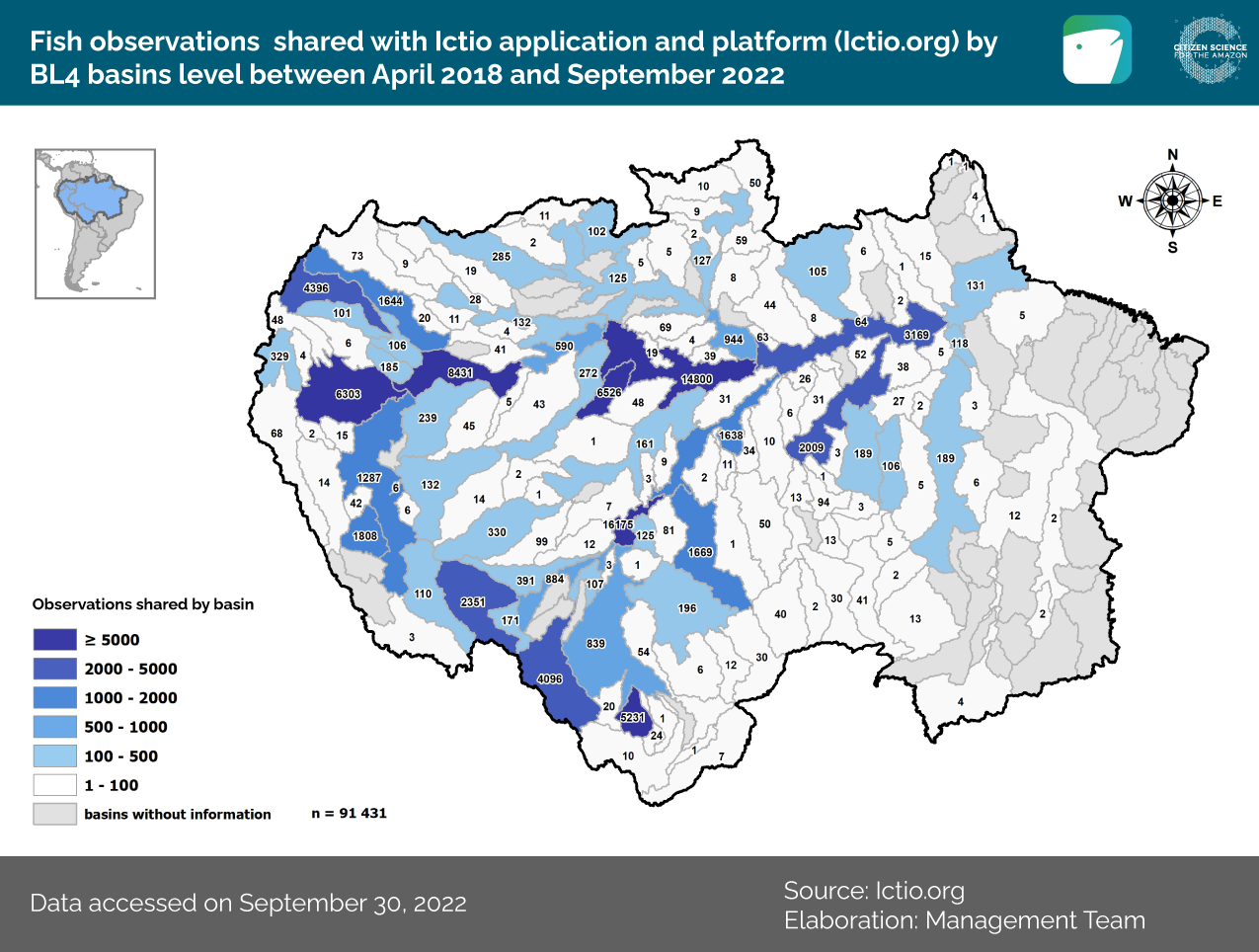
Figure 3. As of September 30, 2022, the Ictio database contains 91,431 fish observations in 52,874 lists. These data come from 150 BL4 basins. The basin with the highest number of observations was the Madeira River (above Jamari), with 16,175 fish observations recorded. Data for the period April 2018 to September 2022, accessed on October 1, 2022.
Source: Ictio.org
Prepared by: Wildlife Conservation Society
Analyzing the fish observations related only to the data sent by the Ictio application, the highlighted basins are the Amazon (above the Jandiatuba river), the Amazon (between the Negro and Xingu rivers), and the Putumayo River (above Igaro Paraná) (Figure 4).
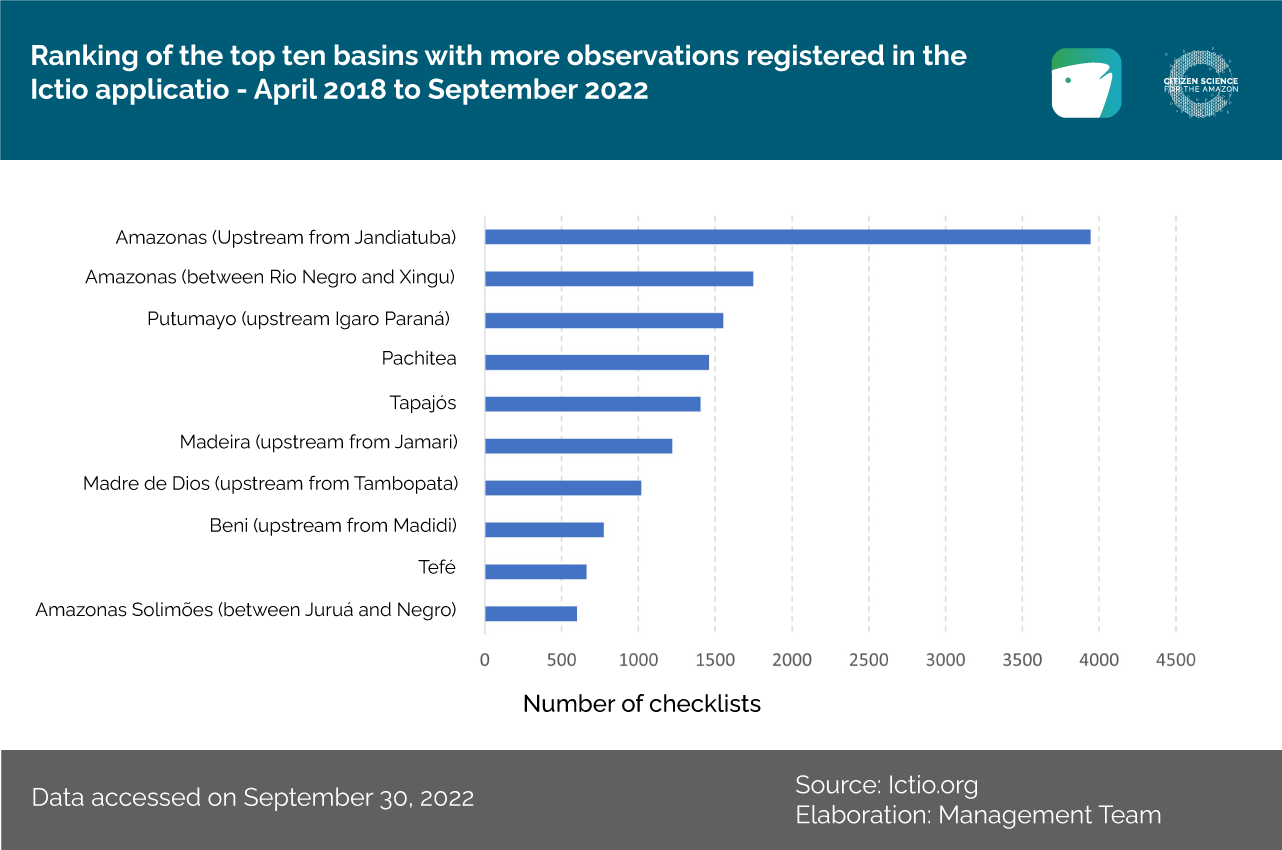
Figure 4. Ranking of the 10 BL4 basins with more observations registered in the Ictio application. The graph follows the trend of having the Amazon BL4 basin (above Jandiatuba) in first place. Data up to September 30, 2022.
Source: Ictio.org
Prepared by: Wildlife Conservation Society
The Ictio application (taking into account all available versions) permitted the recording of 36 species or groups of fish species and a category for characterizing fish that are not included in the program, called “Fish sp.” As of September 2022, the “Fish sp.” category corresponds to 19.7% of the total observations in the database. This category has always had the highest number of records and has helped to evaluate the inclusion or exclusion of submitted fish in the application.
Regarding the type of fish identified and recorded by the Ictio application, the most outstanding is still the Boquichico (genus Prochilodus) with 12% of the observations made until September 2022, followed by the Palometa (Mylossoma spp.) with 6%, the Sardina (Triportheus spp.) with 5.8% and the Lisa (Family Anastomidae) with 5.7% (Figure 5).

Figure 5. Top ten species recorded in the application until September 2022.
Source: Ictio.org
Prepared by: Wildlife Conservation Society
Figure 6 represents the percentage of observations of Boquichico (Prochilodus sp.), the most recorded fish by the app, for each Amazon basin at the BL4 level considering all data from the Ictio database (app and platform). Its presence in headwaters and large rivers is widely known in the Amazon basin, as shown in the records.
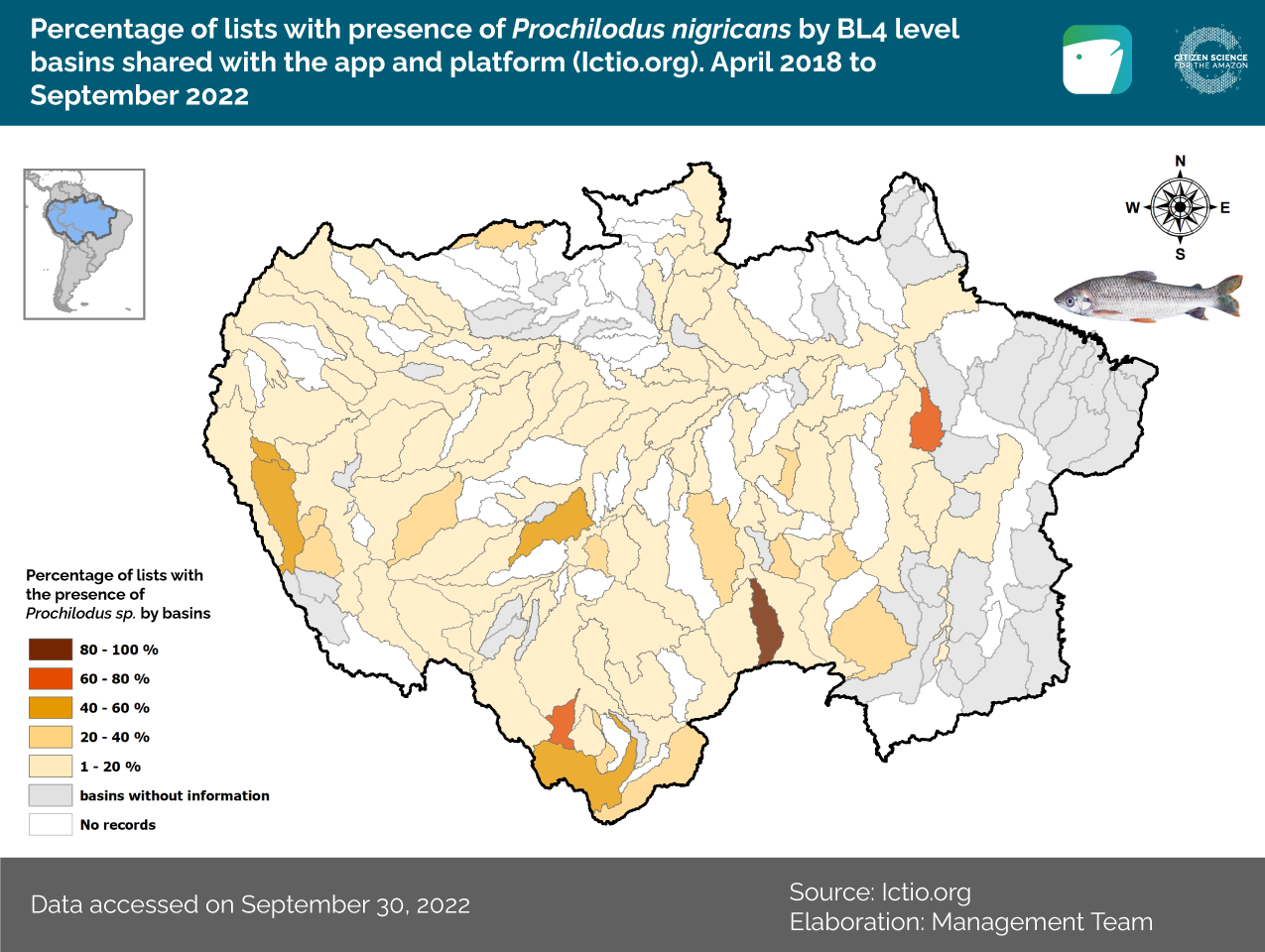
Figure 6. Percentage of listings in the app and web platform with presence of Prochilodus sp. by BL4 level sub-basins. Data for the period April 2018 to September 2022, accessed on 1 October 2022.
Source: Ictio.org
Prepared by: Cornell Lab of Ornithology
In September 2022, Ictio application users recorded 11,464 listings with fish and fishery data in 81 of the 199 BL4 level basins (40.7%). The trend has been maintained in relation to the data accumulated up to the previous period (April 2018 – June 2022), with the main channel of the Amazon River above Jandiatuba, a region between Peru, Brazil and Colombia, having the highest number of lists registered with the Ictio app. This region was followed in numbers of lists by the area formed by the main channel of the Amazon River, between the Negro River and the Xingu River in Brazil; and then the Tapajós River basin (also in Brazil) in third place. However, there was a change, as the Beni River region surpassed the Madre de Dios River region (above Tambopata) in the number of lists sent by the Ictio application.
Looking at the total data (Figure 3), the Madeira River basin shows 37.4% of all fish observations,while 29.5% are in the main channel of the Amazon River. These two large BL2 basins comprise almost 67% of all the current data in the Ictio database, which reaffirms the importance of these regions for fisheries.
As these are important fishing areas, they are also the points of concentration of the largest number of users of the application. As of September 2022, there were 259 (43%) users registered to use the Ictio application in the Madeira river basin, and 151 (25%) in the Amazon river basin. In this basin, we highlight the initiatives of citizen scientists in the BL4 Beni basin (above Madidi), where WCS Bolivia is leading the implementation of Ictio, followed by scientists in the BL4 Amazonas basin (above Jandiatuba), where IBC partners are articulating collective activities with fishing communities through fisheries monitoring. The most active user registered 387 listings are in BL4 Amazonas (above Jandiatuba), Peru. These impressive results demonstrate the continuous and productive work of our partners of the Citizen Science Network for the Amazon.
Learn about the most popular families, genus and species and their common names by country.
Family Anostomidae: lisa, boga (Bolivia); aracu, aracu cabeça-gorda, piau (Brazil); liso, cheo, guaracu (Colombia); liso, tanla (Ecuador); liso (Peru).
Brachyplatystoma rousseauxii : dorado (Bolivia); dourada (Brasil); plateado, dorado (Colombia); plateado (Ecuador); dorado, zúngaro dorado (Peru).
Brycon sp.: yatorana, mamuri, yaturana, matrinchán (Bolivia); matrinxã, jatuarana (Brazil); sábalo, sabaleta, zingo (Colombia), sábalo, mahuaso, katupa or handia (Ecuador) and sábalo (Peru).
Family Curimatidae: llorona, sabalina (Bolivia); branquinha (Brazil); llorón, chillón, sardina (Colombia); sardina (Ecuador); chío chío, yahuarachi, llambina (Peru).
Colossoma macropomum : Pacú, tambaquí (Bolivia), Tambaqui (Brazil), cachama preta, gamitana (Colombia), paco (Ecuador), gamitana (Peru).
Mylossoma sp: pacupeba (Bolivia), pacu (Brasil) and palometa (Colombia, Ecuador y Peru).
Piaractus brachypomus : Tambaquí, Pacu blanco (Bolivia), Pirapitinga (Brazil), Paco, Cachama blanca (Colombia), Cachama blanca (Ecuador), Paco (Peru).
Prochilodus nigricans: sábalo (Bolivia); curimatã, curica ou papa-terra (Brazil); bocachico (Colombia and Equador); challua (Ecuador) and boquichico (Peru).
Pseudoplatystoma sp.: Surubíes (Bolivia), Surubins (Brazil), Pintadillos (Colombia), Pintadillos (Ecuador), Doncella (Peru).
Triportheus sp.: sardina, panete (Bolivia); sardinha (Brazil), sardina (Colombia and Peru) and pechón and sapamama (Ecuador).




